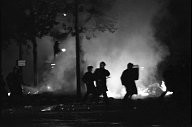Refine search
No keyword found to refine search
keywords EN
Places
Names
307 documents found
| 1 | 6 |
Documents per page :
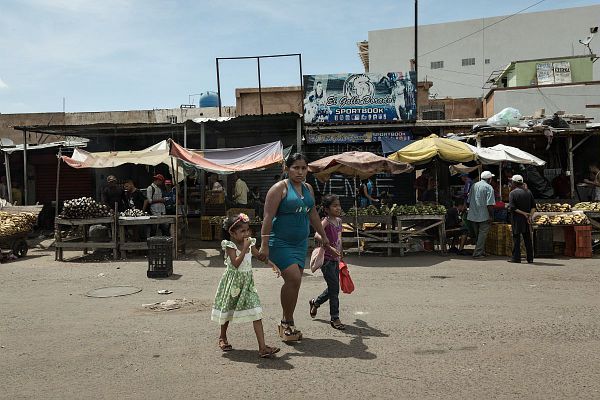
Venezuela - Maracaibo's disaster
Chris Huby / Le Pictorium
LePictorium_0184317.jpg
Venezuela - Maracaibo - General view of the market.
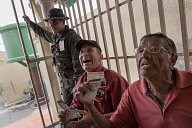
Venezuela - Maracaibo's disaster
Chris Huby / Le Pictorium
LePictorium_0184330.jpg
Venezuela - Maracaibo - The day of the presidential elections, in one of the neighborhoods of the opposition - The opponents boycotted in mass the ballot, only some Chavistes came to appear but the machines do not work and nobody can vote. Some have been waiting for 10 hours. Here voters who show their papers.
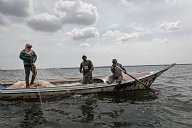
Venezuela - Maracaibo's disaster
Chris Huby / Le Pictorium
LePictorium_0184397.jpg
Venezuela - Maracaibo - The lake - Village of Sabaneta de Palmas - Fishermen in full activity on a lake ravaged by pollution, subject to the laws of pirate mafias and the corruption of the maritime police.

Venezuela - Maracaibo's disaster
Chris Huby / Le Pictorium
LePictorium_0184407.jpg
Venezuela - Maracaibo - The lake - Village of Sabaneta de Palmas - Fishermen in full activity on a lake ravaged by pollution, subject to the laws of pirate mafias and the corruption of the maritime police.
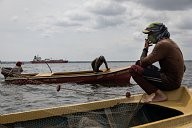
Venezuela - Maracaibo's disaster
Chris Huby / Le Pictorium
LePictorium_0184408.jpg
Venezuela - Maracaibo - The lake - Village of Sabaneta de Palmas - Fishermen in full activity on a lake ravaged by pollution, subject to the laws of pirate mafias and the corruption of the maritime police - the sun beats so much, that they protect their faces.
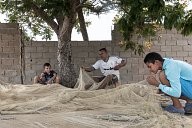
Venezuela - Maracaibo's disaster
Chris Huby / Le Pictorium
LePictorium_0184415.jpg
Venezuela - Maracaibo - The lake - Village of Sabaneta de Palmas - Small fishing village of fish and shrimps - Ambiance, a family stuffs the net, their only important thing.
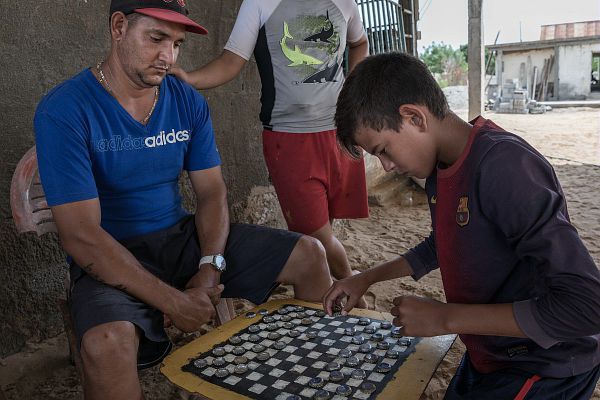
Venezuela - Maracaibo's disaster
Chris Huby / Le Pictorium
LePictorium_0184417.jpg
Venezuela - Maracaibo - The lake - Village of Sabaneta de Palmas - Small fishing village of fish and shrimp - Atmosphere - a child has bottle caps on a game of Checkers.
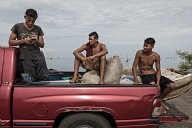
Venezuela - Maracaibo's disaster
Chris Huby / Le Pictorium
LePictorium_0184433.jpg
Venezuela - Maracaibo - LAC - Lagunillas - This bank is devastated by oil spills - Fishermen sell fish on this shore there, despite the oil.
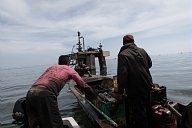
Venezuela - Maracaibo's disaster
Chris Huby / Le Pictorium
LePictorium_0184448.jpg
Venezuela - Maracaibo - LAC - Village of CIUDAD OJEDA - The place is contaminated and polluted by oil in a disastrous way - Portrait of the crab fishermen who despair of the situation with the years - all that they fish is invaded by the oil. The lake on which they have been sailing for years has become totally dark.
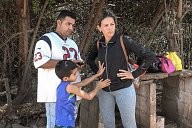
Venezuela - Maracaibo's disaster
Chris Huby / Le Pictorium
LePictorium_0184458.jpg
Venezuela - Maracaibo - Lake - Village of Sabaneta de Palmas - Departure to SAN CARLOS - MarieBel is her family before she goes to fish in Colombia. Her relatives are worried because she takes a dangerous road, with radical mafias and corrupt police officers - the road itself is difficult to practice - MarieBel has become a fish smuggler to feed her family, she resells him tens of times more expensive in Colombia - she goes through the course once a week, risking her life.
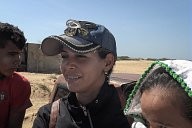
Venezuela - Maracaibo's disaster
Chris Huby / Le Pictorium
LePictorium_0184475.jpg
Venezuela - Maracaibo - Fish traffic - The course - A group of fishermen (forced to trade because of the economic crisis) takes several tens of pounds of fish and shrimp that they will sell in Colombia - From San Carlos to Colombia , a trip that lasts almost half a day with all the illegal steps and caution. Portrait of Mariebel on a journey.
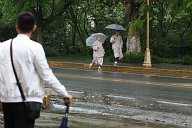
Trip to China.
Jean-Paul Lozouet / Le Pictorium
LePictorium_0179944.jpg
Emeishan, Sichuan, China, two Buddhist nuns walking in the rain.
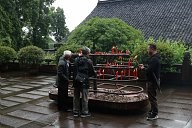
Trip to China.
Jean-Paul Lozouet / Le Pictorium
LePictorium_0179954.jpg
Emeishan, Sichuan, China, candleholder of offerings and devotees in Baoguo Si temple.
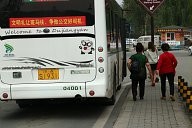
Trip to China.
Jean-Paul Lozouet / Le Pictorium
LePictorium_0179942.jpg
Dujiangyan, Sichuan, China, municipal buses adorned with cool pandas.
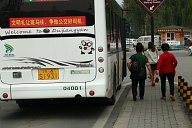
Trip to China.
Jean-Paul Lozouet / Le Pictorium
LePictorium_0179907.jpg
Chengdu, Sichuan, city buses adorned with cool pandas.
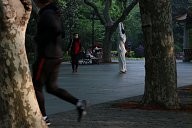
Trip in China
Jean-Paul Lozouet / Le Pictorium
LePictorium_0179615.jpg
Shanghai, People's Republic of China (PRC)
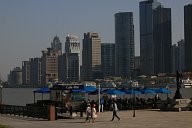
Trip in China
Jean-Paul Lozouet / Le Pictorium
LePictorium_0179686.jpg
Shanghai, People's Republic of China (PRC)
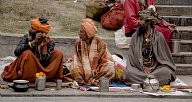
12-13 February, 2018 - Shiva Ratri at the Pashupatinath Temple. It is a very important celebration in Hinduism.
Noémie Repetto / Le Pictorium
LePictorium_0174360.jpg
The Shiva Ratri (or Maha Shiavatri translated as 'The Great Night of Shiva') is normally held on February 13th. However, the sadhus (beggars) begin to gather the day before, the 12th of February. These people go to the temple of Pashupatinath to celebrate the birthday of Lord Shiva. Shiva is represented in the form of yogi or beggar and many other forms, hence the presence of as many beggars from Kathmandu in this temple on this particular day. The name 'Pashupati' is one of the many names that Lord Shiva carries.
The custom of Shiva Ratri is to fast and watch all night by performing a 'pûjâ' every 3 hours (4 times during the night). During these ablutions, milk, curd, butter and finally honey are given as offerings to God, in this order. Each ablution is followed by a bilva leaf offering, appreciated by Shiva.
It is not abnormal, almost expected, to see beggars smoking drugs during this festival.
The custom of Shiva Ratri is to fast and watch all night by performing a 'pûjâ' every 3 hours (4 times during the night). During these ablutions, milk, curd, butter and finally honey are given as offerings to God, in this order. Each ablution is followed by a bilva leaf offering, appreciated by Shiva.
It is not abnormal, almost expected, to see beggars smoking drugs during this festival.
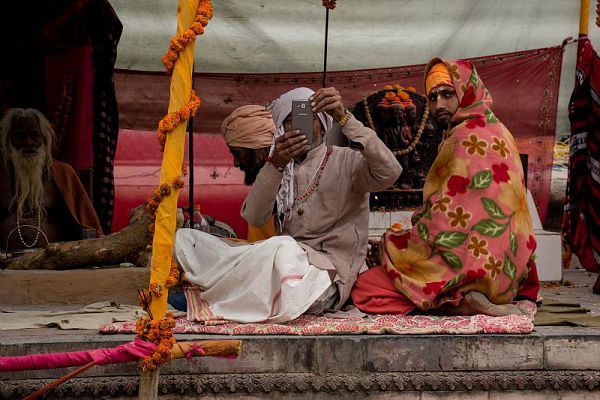
12-13 February, 2018 - Shiva Ratri at the Pashupatinath Temple. It is a very important celebration in Hinduism.
Noémie Repetto / Le Pictorium
LePictorium_0174391.jpg
The Shiva Ratri (or Maha Shiavatri translated as 'The Great Night of Shiva') is normally held on February 13th. However, the sadhus (beggars) begin to gather the day before, the 12th of February. These people go to the temple of Pashupatinath to celebrate the birthday of Lord Shiva. Shiva is represented in the form of yogi or beggar and many other forms, hence the presence of as many beggars from Kathmandu in this temple on this particular day. The name 'Pashupati' is one of the many names that Lord Shiva carries.
The custom of Shiva Ratri is to fast and watch all night by performing a 'pûjâ' every 3 hours (4 times during the night). During these ablutions, milk, curd, butter and finally honey are given as offerings to God, in this order. Each ablution is followed by a bilva leaf offering, appreciated by Shiva.
It is not abnormal, almost expected, to see beggars smoking drugs during this festival.
The custom of Shiva Ratri is to fast and watch all night by performing a 'pûjâ' every 3 hours (4 times during the night). During these ablutions, milk, curd, butter and finally honey are given as offerings to God, in this order. Each ablution is followed by a bilva leaf offering, appreciated by Shiva.
It is not abnormal, almost expected, to see beggars smoking drugs during this festival.
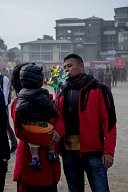
2018, Jan 15 - Maghi festival. New Year of Nepal in Tundikhel through the day. The festival had started from Kathmandu Durbar Square.
Noémie Repetto / Le Pictorium
LePictorium_0173464.jpg
Maghe Sankranti is the first day of the month of Magh of Bikram Sambat. Magh is the tenth month of the year.
Sankranti is the Sanskrit word in Eastern Astrology which refers to the transmigration of the Sun from one Rashi (sign of the zodiac) to another. In very simple, the word sankranti is the first day of the Nepali calendar. Then obviously, there are 12 sankrantis in a year. Makar Sankranti is the transition of the Sun from Dhanu rashi (Sagittarius) to Makara rashi (Capricorn).
In Hindu Astrology the sun position during the year is divided into 12 rashis (zodiac signs). It is however, very difficult to reconcile among Bikram Sambat months, Zodiac months and lunar calendar's months. While the traditional Calendar is based on lunar positions, Sankranti is a solar event. So dates of all Hindu festivals keep changing as per the Gregorian calendar and so do the Makar Sankranti too.
Makar Sankranti is the festival of the Sun God. The Sun God is the symbol of power, divinity and wisdom. The Sun God is worshiped in this festival.
Maghe Sankranti is also called Maghi. Maghi is for the New year of Tharu Community of Nepal.
Sankranti is the Sanskrit word in Eastern Astrology which refers to the transmigration of the Sun from one Rashi (sign of the zodiac) to another. In very simple, the word sankranti is the first day of the Nepali calendar. Then obviously, there are 12 sankrantis in a year. Makar Sankranti is the transition of the Sun from Dhanu rashi (Sagittarius) to Makara rashi (Capricorn).
In Hindu Astrology the sun position during the year is divided into 12 rashis (zodiac signs). It is however, very difficult to reconcile among Bikram Sambat months, Zodiac months and lunar calendar's months. While the traditional Calendar is based on lunar positions, Sankranti is a solar event. So dates of all Hindu festivals keep changing as per the Gregorian calendar and so do the Makar Sankranti too.
Makar Sankranti is the festival of the Sun God. The Sun God is the symbol of power, divinity and wisdom. The Sun God is worshiped in this festival.
Maghe Sankranti is also called Maghi. Maghi is for the New year of Tharu Community of Nepal.

2018, Jan 15 - Maghi festival. New Year of Nepal in Tundikhel through the day. The festival had started from Kathmandu Durbar Square.
Noémie Repetto / Le Pictorium
LePictorium_0173470.jpg
Maghe Sankranti is the first day of the month of Magh of Bikram Sambat. Magh is the tenth month of the year.
Sankranti is the Sanskrit word in Eastern Astrology which refers to the transmigration of the Sun from one Rashi (sign of the zodiac) to another. In very simple, the word sankranti is the first day of the Nepali calendar. Then obviously, there are 12 sankrantis in a year. Makar Sankranti is the transition of the Sun from Dhanu rashi (Sagittarius) to Makara rashi (Capricorn).
In Hindu Astrology the sun position during the year is divided into 12 rashis (zodiac signs). It is however, very difficult to reconcile among Bikram Sambat months, Zodiac months and lunar calendar's months. While the traditional Calendar is based on lunar positions, Sankranti is a solar event. So dates of all Hindu festivals keep changing as per the Gregorian calendar and so do the Makar Sankranti too.
Makar Sankranti is the festival of the Sun God. The Sun God is the symbol of power, divinity and wisdom. The Sun God is worshiped in this festival.
Maghe Sankranti is also called Maghi. Maghi is for the New year of Tharu Community of Nepal.
Sankranti is the Sanskrit word in Eastern Astrology which refers to the transmigration of the Sun from one Rashi (sign of the zodiac) to another. In very simple, the word sankranti is the first day of the Nepali calendar. Then obviously, there are 12 sankrantis in a year. Makar Sankranti is the transition of the Sun from Dhanu rashi (Sagittarius) to Makara rashi (Capricorn).
In Hindu Astrology the sun position during the year is divided into 12 rashis (zodiac signs). It is however, very difficult to reconcile among Bikram Sambat months, Zodiac months and lunar calendar's months. While the traditional Calendar is based on lunar positions, Sankranti is a solar event. So dates of all Hindu festivals keep changing as per the Gregorian calendar and so do the Makar Sankranti too.
Makar Sankranti is the festival of the Sun God. The Sun God is the symbol of power, divinity and wisdom. The Sun God is worshiped in this festival.
Maghe Sankranti is also called Maghi. Maghi is for the New year of Tharu Community of Nepal.
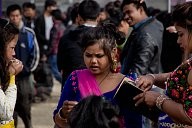
2018, Jan 15 - Maghi festival. New Year of Nepal in Tundikhel through the day. The festival had started from Kathmandu Durbar Square.
Noémie Repetto / Le Pictorium
LePictorium_0173472.jpg
Maghe Sankranti is the first day of the month of Magh of Bikram Sambat. Magh is the tenth month of the year.
Sankranti is the Sanskrit word in Eastern Astrology which refers to the transmigration of the Sun from one Rashi (sign of the zodiac) to another. In very simple, the word sankranti is the first day of the Nepali calendar. Then obviously, there are 12 sankrantis in a year. Makar Sankranti is the transition of the Sun from Dhanu rashi (Sagittarius) to Makara rashi (Capricorn).
In Hindu Astrology the sun position during the year is divided into 12 rashis (zodiac signs). It is however, very difficult to reconcile among Bikram Sambat months, Zodiac months and lunar calendar's months. While the traditional Calendar is based on lunar positions, Sankranti is a solar event. So dates of all Hindu festivals keep changing as per the Gregorian calendar and so do the Makar Sankranti too.
Makar Sankranti is the festival of the Sun God. The Sun God is the symbol of power, divinity and wisdom. The Sun God is worshiped in this festival.
Maghe Sankranti is also called Maghi. Maghi is for the New year of Tharu Community of Nepal.
Sankranti is the Sanskrit word in Eastern Astrology which refers to the transmigration of the Sun from one Rashi (sign of the zodiac) to another. In very simple, the word sankranti is the first day of the Nepali calendar. Then obviously, there are 12 sankrantis in a year. Makar Sankranti is the transition of the Sun from Dhanu rashi (Sagittarius) to Makara rashi (Capricorn).
In Hindu Astrology the sun position during the year is divided into 12 rashis (zodiac signs). It is however, very difficult to reconcile among Bikram Sambat months, Zodiac months and lunar calendar's months. While the traditional Calendar is based on lunar positions, Sankranti is a solar event. So dates of all Hindu festivals keep changing as per the Gregorian calendar and so do the Makar Sankranti too.
Makar Sankranti is the festival of the Sun God. The Sun God is the symbol of power, divinity and wisdom. The Sun God is worshiped in this festival.
Maghe Sankranti is also called Maghi. Maghi is for the New year of Tharu Community of Nepal.
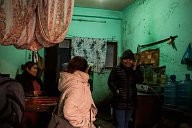
Nepal - Katmandou Valley. Visit of the businesses followed by the WOFOWON organisation.
Noémie Repetto / Le Pictorium
LePictorium_0173234.jpg
Small businesses owned exclusively by women. The WOFOWON (Women Forum for Women in Nepal) is an NGO helping those people.
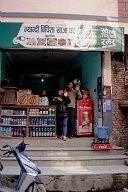
Nepal - Katmandou Valley. Visit of the businesses followed by the WOFOWON organisation.
Noémie Repetto / Le Pictorium
LePictorium_0173242.jpg
Small businesses owned exclusively by women. The WOFOWON (Women Forum for Women in Nepal) is an NGO helping those people.
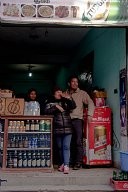
Nepal - Katmandou Valley. Visit of the businesses followed by the WOFOWON organisation.
Noémie Repetto / Le Pictorium
LePictorium_0173243.jpg
Small businesses owned exclusively by women. The WOFOWON (Women Forum for Women in Nepal) is an NGO helping those people.
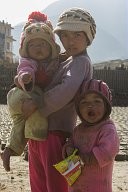
Nepal - Kathmandu Valley - Kirtipur. Handmade Bricks factory
Noémie Repetto / Le Pictorium
LePictorium_0173038.jpg
Nepal divides its citizens according to social caste. The weakest caste, called the 'untouchables', deals with the hardest and least socially rewarding jobs. The brick factory is a good example. In the Kathmandu Valley, the cities of Kirtipur and Bhaktapur are the cities where factories and factories are built.
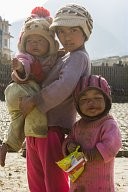
Nepal - Kathmandu Valley - Kirtipur. Handmade Bricks factory
Noémie Repetto / Le Pictorium
LePictorium_0173039.jpg
Nepal divides its citizens according to social caste. The weakest caste, called the 'untouchables', deals with the hardest and least socially rewarding jobs. The brick factory is a good example. In the Kathmandu Valley, the cities of Kirtipur and Bhaktapur are the cities where factories and factories are built.
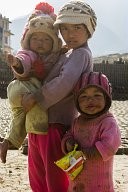
Nepal - Kathmandu Valley - Kirtipur. Handmade Bricks factory
Noémie Repetto / Le Pictorium
LePictorium_0173040.jpg
Nepal divides its citizens according to social caste. The weakest caste, called the 'untouchables', deals with the hardest and least socially rewarding jobs. The brick factory is a good example. In the Kathmandu Valley, the cities of Kirtipur and Bhaktapur are the cities where factories and factories are built.
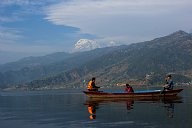
Nepal - Pokhara.
Noémie Repetto / Le Pictorium
LePictorium_0172985.jpg
Nepal - Pokhara, a city appreciated for its rendezvous point for trekkers. City mainly for tourists.
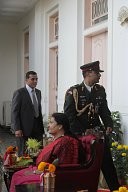
Tika ceremony in Nepal
Noémie Repetto / Le Pictorium
LePictorium_0168893.jpg
Bidya Devi Bhandari, President of Nepal, puts red on the front during the Tika ceremony.
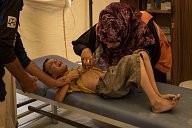
Syria: Ain Issa displaced people camp
Chris Huby / Le Pictorium
LePictorium_0165809.jpg
July 2017 - Syria - Rojava - Northern Syria - Ain Issa displaced people camp / Doctors Without Borders Clinic / A young Syrian boy coming from Rakka is having his stitches difficultly removed.
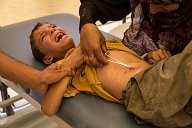
Syria: Ain Issa displaced people camp
Chris Huby / Le Pictorium
LePictorium_0165810.jpg
July 2017 - Syria - Rojava - Northern Syria - Ain Issa displaced people camp / Doctors Without Borders Clinic / A young Syrian boy coming from Rakka is having his stitches difficultly removed.
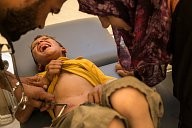
Syria: Ain Issa displaced people camp
Chris Huby / Le Pictorium
LePictorium_0165811.jpg
July 2017 - Syria - Rojava - Northern Syria - Ain Issa displaced people camp / Doctors Without Borders Clinic / A young Syrian boy coming from Rakka is having his stitches difficultly removed.
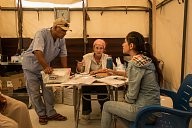
Syria : displaced people camp of Ain Issa.
Chris Huby / Le Pictorium
LePictorium_0165834.jpg
July 2017 - Syria - Rojava - Northern Syria - Aïn Issa displaced camp / MSF clinic / Ambience office under the care tent with Emilie, French general practitioner.
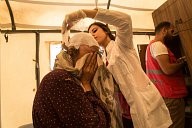
Syria : displaced people camp of Ain Issa.
Chris Huby / Le Pictorium
LePictorium_0165848.jpg
July 2017 - Syria - Rojava - Northern Syria - Aïn Issa Displaced Camp / MSF Clinic / A Syrian woman from Raqqa is treated for a head injury by the NGO's doctors.
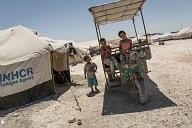
Syria : displaced people camp of Ain Issa.
Chris Huby / Le Pictorium
LePictorium_0165854.jpg
July 2017 - Syria - Rojava - Northern Syria - Aïn Issa Displaced Camp / Ambiance de camp / Children of the camp.

SYRIE / The Freedom Katiba against RAQQA / LIWA AL TAHRIR
Chris Huby / Le Pictorium
LePictorium_0165254.jpg
Syria / Raqqa / West District / Hawi al-Hawa / Frontline. A patrol of Kurds circulates in one of the districts recently taken over in Daesh. Several Arab groups of the SDF (Syrian Democratic Forces) are installed in houses taken over in Daesh. This unit belongs to Liwa Al-Tharir, a brigade of Arab fighters who decided to fight with the fanatics of the EI.
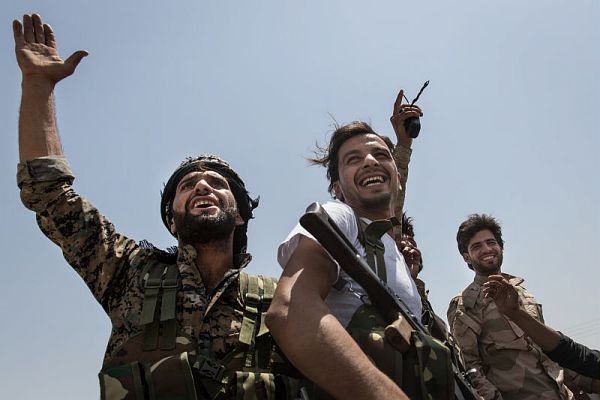
SYRIE / The Freedom Katiba against RAQQA / LIWA AL TAHRIR
Chris Huby / Le Pictorium
LePictorium_0165256.jpg
Syria / Raqqa / West District / Hawi al-Hawa / Frontline. Group photo of Arab fighters in their pickup, during a base change. Several Arab groups of the SDF (Syrian Democratic Forces) are installed in houses taken over in Daesh. This unit belongs to Liwa Al-Tharir, a brigade of Arab fighters who decided to fight with the fanatics of the EI.
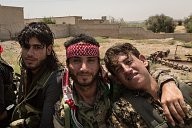
SYRIE / The Freedom Katiba against RAQQA / LIWA AL TAHRIR
Chris Huby / Le Pictorium
LePictorium_0165260.jpg
Syria / Raqqa / West District / Hawi al-Hawa / Frontline. Group photo of Arab fighters in their pickup, during a base change. Several Arab groups of the SDF (Syrian Democratic Forces) are installed in houses taken over in Daesh. This unit belongs to Liwa Al-Tharir, a brigade of Arab fighters who decided to fight with the fanatics of the EI.
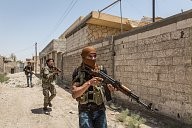
SYRIE / The Freedom Katiba against RAQQA / LIWA AL TAHRIR
Chris Huby / Le Pictorium
LePictorium_0165286.jpg
Syria / Raqqa / West District / Hawi al-Hawa / Frontline. Arab fighters sneak into the streets of the neighborhood to dislodge the possible last fighters of Daesh.
Several Arab groups of the SDF (Syrian Democratic Forces) are installed in houses taken over in Daesh. This unit belongs to Liwa Al-Tharir, a brigade of Arab fighters who decided to fight with the fanatics of the EI.
Several Arab groups of the SDF (Syrian Democratic Forces) are installed in houses taken over in Daesh. This unit belongs to Liwa Al-Tharir, a brigade of Arab fighters who decided to fight with the fanatics of the EI.
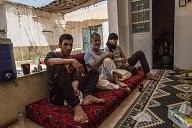
SYRIE / The Freedom Katiba against RAQQA / LIWA AL TAHRIR
Chris Huby / Le Pictorium
LePictorium_0165322.jpg
Syria / Raqqa / West District / Hawi al-Hawa / Frontline. Atmosphere in the house, the Arab fighters are busy waiting for the new orders that will arrive.
Several Arab groups of the SDF (Syrian Democratic Forces) are installed in houses taken over in Daesh. This unit belongs to Liwa Al-Tharir, a brigade of Arab fighters who decided to fight with the fanatics of the EI.
Several Arab groups of the SDF (Syrian Democratic Forces) are installed in houses taken over in Daesh. This unit belongs to Liwa Al-Tharir, a brigade of Arab fighters who decided to fight with the fanatics of the EI.
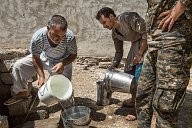
SYRIE / The Freedom Katiba against RAQQA / LIWA AL TAHRIR
Chris Huby / Le Pictorium
LePictorium_0165329.jpg
Syria / Raqqa / West District / Hawi al-Hawa / Frontline. The Arab fighters have found a source of water that will allow them to do their ablutions.
Several Arab groups of the SDF (Syrian Democratic Forces) are installed in houses taken over in Daesh. This unit belongs to Liwa Al-Tharir, a brigade of Arab fighters who decided to fight with the fanatics of the EI.
Several Arab groups of the SDF (Syrian Democratic Forces) are installed in houses taken over in Daesh. This unit belongs to Liwa Al-Tharir, a brigade of Arab fighters who decided to fight with the fanatics of the EI.
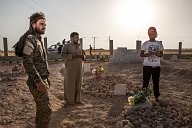
SYRIE / The Freedom Katiba against RAQQA / LIWA AL TAHRIR
Chris Huby / Le Pictorium
LePictorium_0165352.jpg
Syria / Tal Abyad / Ismael and Hout's uncle bitterly gather at Hut's grave dead in battle less than 48 hours ago, killed by Daesh sniper / Several Arab groups in the Syrian Democratic Forces Houses taken over in Daesh. This unit belongs to Liwa Al-Tharir, a brigade of Arab fighters who decided to fight with the fanatics of the EI.
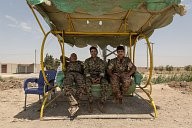
SYRIA / ROJAVA / RAQQA IS BLEEDING - WRATH OF THE EUPHRATE June/July 2017
Chris Huby / Le Pictorium
LePictorium_0164827.jpg
July 2017 - Syria / ROJAVA (North Syrian) / Western Raqqa / West Frontline Checkpoint / Three members of the Syrian Democratic Forces (SDF), Yuri Kurds, are sitting in a shaded swing at the frontline, a few kms further.
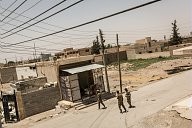
SYRIA / ROJAVA / RAQQA IS BLEEDING - WRATH OF THE EUPHRATE June/July 2017
Chris Huby / Le Pictorium
LePictorium_0164831.jpg
July 2017 - Syria / ROJAVA (Syrian North) / Raqqa West / Frontline / A YPG group is making a round in an EAS district of the Raqqa frontline.
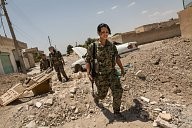
SYRIA / ROJAVA / RAQQA IS BLEEDING - WRATH OF THE EUPHRATE June/July 2017
Chris Huby / Le Pictorium
LePictorium_0164836.jpg
July 2017 - Syria / ROJAVA (Northern Syria) / Raqqa West / Frontline / YPJ soldiers cross a street destroyed by the conflict. Kurds use men and women equally throughout society, including the military.
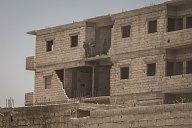
SYRIA / ROJAVA / RAQQA IS BLEEDING - WRATH OF THE EUPHRATE June/July 2017
Chris Huby / Le Pictorium
LePictorium_0164844.jpg
July 2017 - Syria / ROJAVA (Syrian North) / Raqqa West / Frontline / Soldiers of the FDS (Syrian Democratic Forces) are perched in a building destroyed by the conflict, a few tens of meters from ISIS. They inform other YPGs on the ground for street crossings.
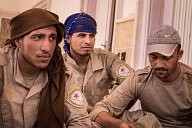
SYRIA / ROJAVA / RAQQA IS BLEEDING - WRATH OF THE EUPHRATE June/July 2017
Chris Huby / Le Pictorium
LePictorium_0164865.jpg
Syria / Rojava (Syrian North) / Raqqa / East Quarter / Frontline. Arab callers have joined the FDS. Originally from Hassake, Tal Abya and Qamishli.
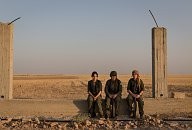
SYRIA / ROJAVA / RAQQA IS BLEEDING - WRATH OF THE EUPHRATE June/July 2017
Chris Huby / Le Pictorium
LePictorium_0164872.jpg
July 2017 - Syria / ROJAVA (Syrian North) / Tal Abyad / At the end of the day, Kurdish soldiers ASAYIS (Kurdish police) are watching a martyr burial ceremony.
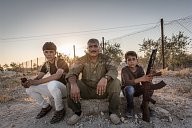
SYRIA / ROJAVA / RAQQA IS BLEEDING - WRATH OF THE EUPHRATE June/July 2017
Chris Huby / Le Pictorium
LePictorium_0164877.jpg
July 2017 - Syria / ROJAVA (Syrian North) / Kobané / At a demonstration against Turkey (about the town of Afrin) a father poses with his two children at sunset.

SYRIA - THE MARTYRDOM OF KHABOUR'S ASSYRIANS
Chris Huby / Le Pictorium
LePictorium_0159744.jpg
SYRIA / NORTH SYRIEN / 24 Dec16 / HASSAKE - The Orthodox Syriac Scouts are preparing for the Christmas party.
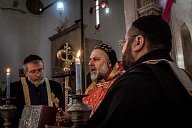
SYRIA - THE MARTYRDOM OF KHABOUR'S ASSYRIANS
Chris Huby / Le Pictorium
LePictorium_0159761.jpg
SYRIA / NORTH SYRIEN / 24 Dec16 / HASSAKE - The Othodox celebrate Christmas in their neighborhood. Believers came early to mass.

Syria / Rojava - Wrath of the Euphrates
Chris Huby / Le Pictorium
LePictorium_0159517.jpg
Dec16 - SYRIA - ROJAVA - AIN-ISSA - Kurdish YPJ soldiers (female soldiers), the close guard of Rojda Felat.
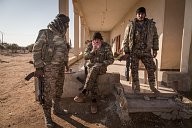
Syria / Rojava - Wrath of the Euphrates
Chris Huby / Le Pictorium
LePictorium_0159527.jpg
SYRIA / ROJAVA / SHE BHER village - Portrait of a YPG soldier. This place is not far from Raqqa.
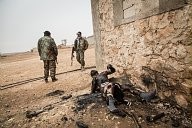
Syria / Rojava - Wrath of the Euphrates
Chris Huby / Le Pictorium
LePictorium_0159541.jpg
SYRIA ROJAVA / This village was just took off from ISIS by the YPG SOLDIERS. An Isis member was just killed. His dead boby was dropped on the ground, totally burned.
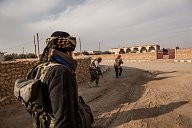
Syria / Rojava - Wrath of the Euphrates
Chris Huby / Le Pictorium
LePictorium_0159561.jpg
Syria ROJAVA / Dec16 - Jan17. Two arab soldiers from SDF are running trough an ISIS village. Mahmudli Village.
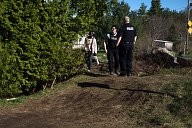
Gentle border jumper arrests in St Bernard de Lacolle, Québec, Canada
Arnaud De Grave / Le Pictorium
LePictorium_0158544.jpg
RCMP cops apprehend a person who just arrived in a taxi to cross the border illegally, get arrested and claim asylum. He comes from Nigeria. The arrest is very gentle despite the fact that he has to be handcuffed and his meager possessions are taken away. “We are the police but we are also human
beings...”
beings...”
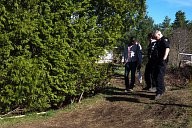
Gentle border jumper arrests in St Bernard de Lacolle, Québec, Canada
Arnaud De Grave / Le Pictorium
LePictorium_0158545.jpg
RCMP cops apprehend a person who just arrived in a taxi to cross the border illegally, get arrested and claim asylum. He comes from Nigeria. The arrest is very gentle despite the fact that he has to be handcuffed and his meager possessions are taken away. “We are the police but we are also human
beings...”
beings...”
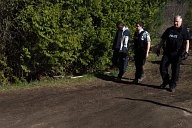
Gentle border jumper arrests in St Bernard de Lacolle, Québec, Canada
Arnaud De Grave / Le Pictorium
LePictorium_0158546.jpg
RCMP cops apprehend a person who just arrived in a taxi to cross the border illegally, get arrested and claim asylum. He comes from Nigeria. The arrest is very gentle despite the fact that he has to be handcuffed and his meager possessions are taken away. “We are the police but we are also human
beings...”
beings...”
Next page

